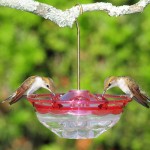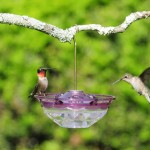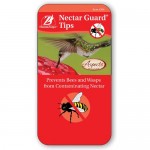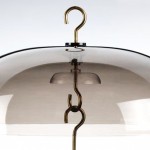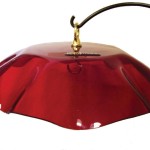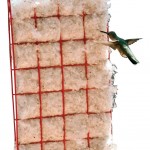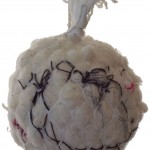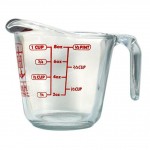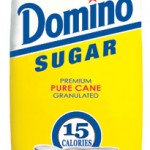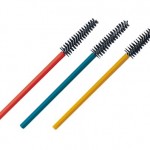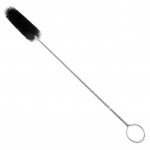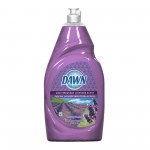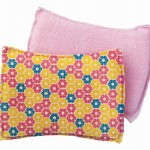It’s been my pleasure to be our hummingbirds’ (Scout, Honey, Tibolt, Lili, +?) temporary guardian until their return to the South. I like to believe that Westchester NY is home and the Carolinas, Florida, or Mexico are their version of a holiday ;) This year I began putting out feeders in the beginning of June but I plan to hang feeders perhaps the last week of April 2015 to welcome them back home =). As I have promised… hummingbird care…
Nectar Feeder & Nectar Guard Tips/Feeding Port Guards: Aspect’s HummBlossom 4oz. red/rose & purple/plum. I have two extra HummBlossoms to maintain a constant rotation… for them, no waiting ;). BTW, if you were wondering whether red or purple makes a difference, know that they will gladly accept nectar in either colored feeder.
Shelter from the Elements: A Humbrella provides the following… “protects hanging hummingbird feeders from the elements and crawling insects. Solar grey color slows evaporation,” as per Amazon. I’d like to add a shady place to take a short rest and a way to still be able to watch the environment around them while they are feeding. I have been very pleased with all my purchases.
I’m reserving the red hummer-friendly dome especially for end of the season when there might be a few hummingbird stragglers desperately searching for food. Since this is my first year caring for hummers I’m not sure what to expect; I may need to keep my feeders out until October/possibly November? A friend who also lives in Westchester NY has told me that she and her husband have seen more hummers and other hummingbird species aside from the ruby-throats beginning late summer. Something to look forward to =)!
Recently we’ve endured some heavy rainstorms so unfortunately one of my nectar feeders came flying off the Humbrella hook, but fortunately the feeder was found intact (was afraid that it would break against the stone path which cuts through my garden or that it couldn’t be easily located after the jostling from heavy winds). I had thought long and hard to consider the best way to secure the feeder to the hook and remembered that I had successfully used twisty ties to prevent our squirrels from stealing an entire cake out of our suet feeder. If you are not a fan of the twisties, you may also use a medium-sized gear tube tie/rubber tie (can be purchased from Home Depot or any local hardware store)… I find that it has done the trick perfectly…
Nesting Supplies: Female hummingbirds use spider webs (to help hold nesting materials together), lichen, parts of flowers e.g. dandelions, and bits of cotton or thick threads for nest-building… and this is where you come in ;) (see below). Male hummingbirds do not play a role in creating the nest or rearing young or even feeding the mother of their offspring like in other bird species so let us do our part to help the females; I’m sure they would appreciate it… Also, while male hummers have ample opportunity to bulk up before flying south, the new mothers may unfortunately lose a lot of their weight in caring for their young. Please take into account their arduous flight south during the Fall, leaving very little time for the females to rebuild their nutrition and regain some weight :(. I believe this makes them even more deserving of some extra help. I keep these nesting materials either under a weather dome or tied to a tree branch below thick foliage; they dry amazingly quickly after storms so not to worry!
Nectar: 1/4 Domino pure cane granulated sugar + 1/2 cups hot water (to melt sugar) + 1/2 cups cold water (please remember to cool the solution before offering to them!)= will fill 2 HummBlossoms perfectly with no leftovers. I have refrigerated the homemade nectar solution for a day or two if I made early preparations then re-heated (again, only offer nectar after cooling!) My personal preference is to not use commercial or red-dyed nectar because using granulated pure cane sugar is affordable, healthier, and meets their nutritional needs (comes closest to the nectar of flowers). Please don’t use honey, syrup, or any artificial sweeteners since these have been known to be harmful!
Cleaning: Dishwashing liquid, warm to hot water, dedicated sponge, bottle brush, mini brushes, plus very thorough scrubbing and rinsing! Remember to carefully clean and rotate usage of nectar guard tips as well!
Nectar Change: Every 2.5 days (though it has been listed on various websites that 3-4 days as still okay; remember to keep in mind the weather conditions & temperatures), I do spoil them a little but honestly I wouldn’t want to drink from the same dirty glass for 2 days, would you? The development of black mold in nectar can make your little feathered friends very ill and has been known to cause death.
Jeweled Hummingbird Swing: This isn’t a must but it’s a cute idea… a hummingbird swing, which provides a place to rest as they are keeping vigil near their food source. I’ve seen small birds perching on the one my husband had set up but in the following You Tube videos, you will see that hummers are indeed also drawn to it given the right spot…
Video 1: https://www.youtube.com/watch?v=4HywkHUXNy8
Video 2: https://www.youtube.com/watch?v=MIyG7yR79ns
*Photocredits: Amazon.com
I purchased most of my supplies through Amazon or my local markets. Click on the pictures for product brand names and descriptions. Please view my previous post regarding ant guards. Feel free to contact me using the webform below if you have further questions. I will cover the topic of Zone 6 plants and flowers to attract hummingbirds in an upcoming post.
Hummingbirds play a very important role in pollination (especially consider the grave decrease in the honeybee population). Hummers also eat undesirable soft-bodied insects like ants, mosquitos, aphids, gnats, among others… so in caring for them, you are also contributing to the balance and well-being of nature.
‘Til next time, XOXO…
